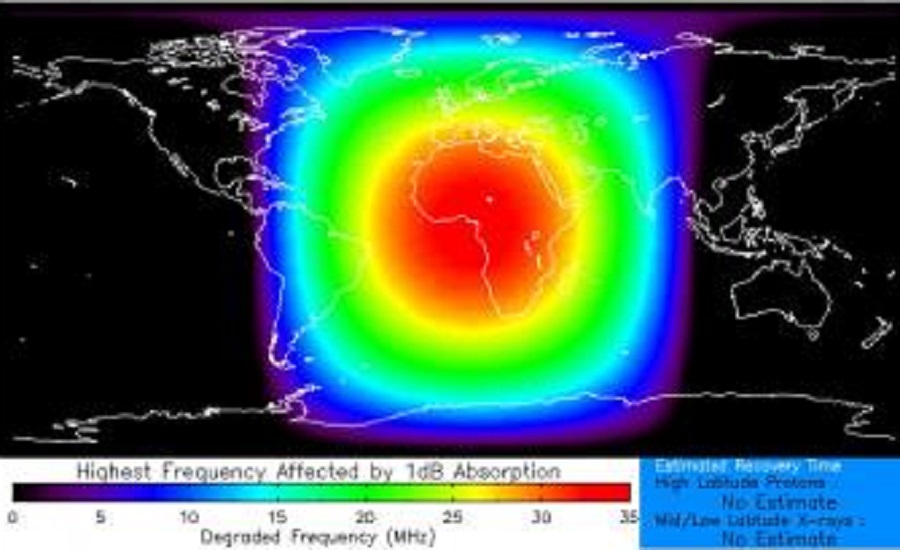
A dramatic explosion unfolded on the surface of the Sun today, prompting a variety of warnings to be issued to Earth. A potent M4 flare facing the Earth erupted from the Sun, generating Radiation Storm Warning conditions on Earth. The flare also produced a coronal mass ejection (CME) which is forecast to bring moderate (G2) Geomagnetic Storm Conditions to Earth on Wednesday. A radio black-out was also caused by today’s blast. Multiple hazards and dangers are present today and will continue for the next few days.
First, the radiation blast associated with today’s flare may not only bring harm to astronauts in space, but to airline passengers and crew on Earth. According to NOAA’s Space Weather Prediction Center (SWPC), “An enhancement in the energetic portion of the solar radiation spectrum may indicate increased biological risk to astronauts or passengers and crew in high latitude, high altitude flights.” Beyond impacting humans, the excess radiation could also harm electronics. “Energetic particles may represent an increased risk to all satellite systems susceptible to single event effects. This information should be used in conjunction with the current Solar Radiation Storm conditions when assessing overall impact,” the SWPC said in a bulletin today.
According to the SWPC, the M4 flare occurred at 7:29 am ET today (1129 UTC). The flare source location was a magnetically complex sunspot group, Region 2975 and was associated with a solar proton event that reached S1 (Minor) storm levels at 9:25 am ET (1325 UTC). The SWPC says that radio frequency signatures were detected suggestive of a coronal mass ejection (CME). In the latest update, the SWPC said, “Recent coronagraph imagery from the NASA/SOHO LASCO instrument verifies a CME occurred, and we are awaiting further imagery to properly conduct an in-depth analysis to determine the possibility of any Earth-directed component.”
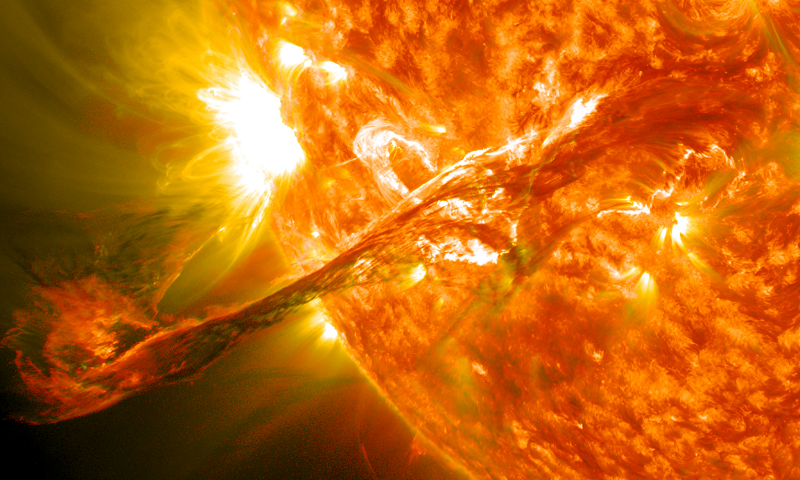
Solar flares are giant explosions on the sun that send energy, light and high speed particles into space. These flares are often associated with solar magnetic storms known as coronal mass ejections (CMEs). Flares are ranked on a classification system that divides solar flares according to their strength. The smallest ones are A-class (near background levels), followed by B, C, M and X. Similar to the Richter scale for earthquakes, each letter represents a 10-fold increase in energy output. So an X is ten times an M and 100 times a C. Within each letter class there is a finer scale from 1 to 9. C-class and smaller flares are too weak to noticeably affect Earth. M-class flares can cause brief radio blackouts at the poles and minor radiation storms that might endanger astronauts. According to NASA, although X is the last letter, there are flares more than 10 times the power of an X1, so X-class flares can go higher than 9. NASA says the most powerful flare measured with modern methods was in 2003, during the last solar maximum, and it was so powerful that it overloaded the sensors measuring it. Those sensors cut out at X28.
The biggest X-class flares are by far the largest explosions in the solar system; in the largest events, these eruptive events can produce as much energy as a billion hydrogen bombs.
According to the SWPC, potentially hazardous geoelectric fields can be induced during geomagnetic storms. These geomagnetic storms are a form of space weather driven by enhanced currents in Earth’s magnetosphere and ionosphere and are observed at ground level as a time-varying magnetic field. As is well known from Faraday’s law, a time-varying magnetic field induces currents along natural and artificial conducting pathways by means of an induced electric field. The SWPC has unveiled a new mapping product which illustrates the geoelectric field based on information about the time-varying magnetic field together with Earth-conductivity information to estimate regional geoelectric fields on a geographic grid over the lower 48 states. The amount of current induced in an artificial conductor may be calculated by integrating the electric field along the conducting pathway. When currents are induced in artificial conductors, unexpected and sometimes problematic effects can occur in the operation of the affected equipment

Image: NASA/Mary Pat Hrybyk-Keith
The Space Weather Prediction Center believes this CME will bring about moderate Geomagnetic Storm conditions on Thursday, March 31. A G2 class Moderate Geomagnetic Storm is forecast to occur. Geomagnetic storms are rated on a 1-5 scale, with 5 being extremely disruptive and destructive to life. A G1 rated Geomagnetic storm impacted Earth on Sunday. For this next storm, high-latitude power systems may experience voltage alarms and transformer damage. Spacecraft operations for space stations and satellites could also be impacted. High frequency (HF) radio propagation can fade at higher latitudes during such a storm. Navigation and communication systems could face interference or poor operation throughout the storm. Aurora may also become visible in cloud-free night skies as far south as a line stretching from Idaho to New York.
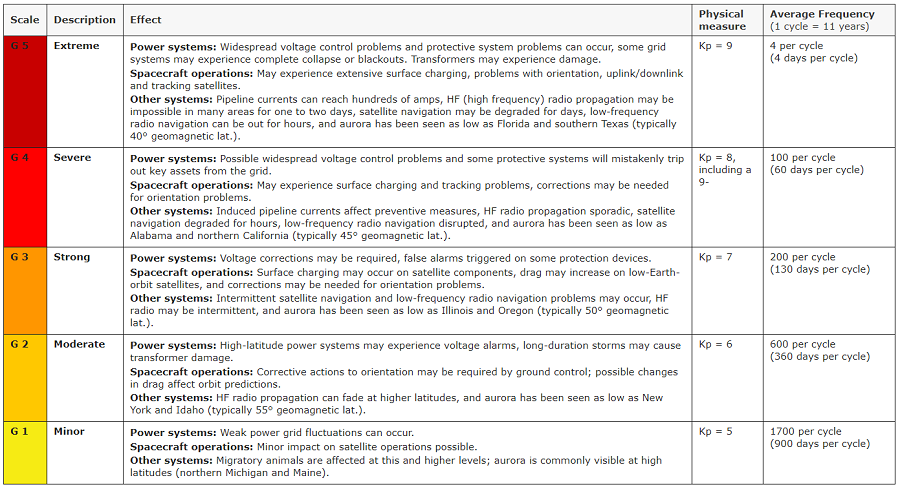

NOAA forecasters analyze a variety of solar data from spacecraft to determine what impacts a geomagnetic storm could produce. If Earth is experiencing the effects of a coronal hole and a coronal mass ejection is forecasted to impact Earth, the combined effects could result in a more significant impact and more intense geomagnetic storming. Analyzing data from the DSCOVER and ACE satellite is one way forecasters can tell when the enhanced solar wind from a coronal hole is about to arrive at Earth. A few things they look for in the data to determine when the enhanced solar wind is arriving at Earth:
• Solar wind speed increases
• Temperature increases
• Particle density decreases
• Interplanetary magnetic field (IMF) strength increases
While these solar events can help illuminate the sky with stunning aurora, they can also do considerable harm to electronics, electrical grids, and satellite and radio communications.
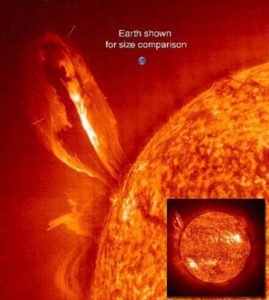
The 1859 incident, which occurred on September 1-2 in 1859, is also known as the “Carrington Event.” This event unfolded as powerful geomagnetic storm struck Earth during Solar Cycle 10. A CME hit the Earth and induced the largest geomagnetic storm on record. The storm was so intense it created extremely bright, vivid aurora throughout the planet: people in California thought the sun rose early, people in the northeastern U.S. could read a newspaper at night from the aurora’s bright light, and people as far south as Hawaii and south-central Mexico could see the aurora in the sky.
The event severely damaged the limited electrical and communication lines that existed at that time; telegraph systems around the world failed, with some telegraph operators reporting they received electric shocks.
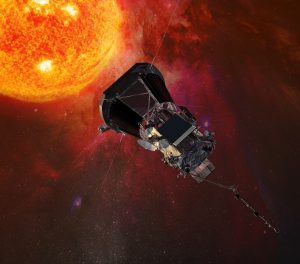
A June 2013 study by Lloyd’s of London and Atmospheric and Environmental Research (AER) in the U.S. showed that if the Carrington event happened in modern times, damages in the U.S. could exceed $2.6 trillion, roughly 15% of the nation’s annual GDP.
While typically known for their weather forecasts, the National Oceanic and Atmospheric Administration (NOAA) and its National Weather Service (NWS) is also responsible for “space weather.” While there are private companies and other agencies that monitor and forecast space weather, the official source for alerts and warnings of the space environment is the Space Weather Prediction Center (SWPC). The SWPC is located in Boulder, Colorado and is a service center of the NWS, which is part of NOAA. The Space Weather Prediction Center is also one of nine National Centers for Environmental Prediction (NCEP) as they monitor current space weather activity 24/7, 365 days a year.